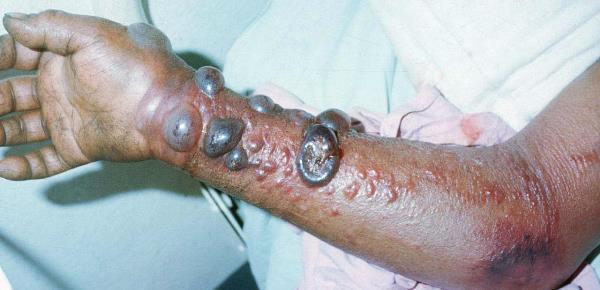What causes Marburg disease?
Marburg and Ebola viruses are considered to be zoonotic infections (transmitted to humans from life cycles in other animals). Although it is unclear as to which animals contain both Marburg and Ebola, it is thought that both may be transmitted to humans from monkeys and/or bats (African fruit bat and Rousettus bat). There is no evidence for any insect vectors. Although it is unclear how humans contract these viruses from other animals (perhaps by eating them or by contamination of animal body fluids), it is clear that human-to-human transfer occurs by direct contact with an infected person’s bodily fluids (for example, saliva, tears, excretions, vomitus, and blood). The Marburg viruses are not thought to be spread by air droplets.

What are the symptoms and signs of Marburg infection? What is the incubation period for a Marburg virus infection?
The symptoms of Marburg virus infection usually come on suddenly after an incubation period of about five to 10 days. Early symptoms are as follows:
- Fever
- Chills
- Headache
- Muscle aches
About five days after the symptoms first occur, other symptoms may occur as follows:
- A rash occurs on the chest, back, and stomach in some individuals.
- Nausea
- Vomiting
- Chest pain
- Sore throat
- Abdominal pain
- Diarrhea may appear.
Symptoms continue and can become severe; they include the following:
- Jaundice
- Pancreatic inflammation
- Severe weight loss
- Delirium
- Liver failure
- Massive hemorrhaging with organ dysfunction
The case fatality rate (death rate) ranges from about 23%-90% of infected individuals. Many of the symptoms are similar to those of other infectious diseases such as Ebola, malaria, typhoid fever, and others; so diagnostic tests are useful to rule out other causes of the symptoms. People exposed to Marburg virus usually show signs of infection no later than about 14 days after exposure, but because the clinical symptoms resemble Ebola virus disease, most people are placed in isolation for 21 days.
What are risk factors for getting Marburg infections?
People at risk are those who come in contact with African monkeys (bush meat means meat from monkeys) and bats; individuals who do research on these viruses are also at higher risk of becoming infected. There have been several outbreaks in Africa in miners due to their exposure to bats. Veterinarians may also be at higher risk if they are exposed to African monkeys. Also, people who care for Marburg virus-infected patients and/or health workers who remove those bodies of deceased Marburg virus-infected patients are at high risk of contracting the disease.
How do health-care professionals diagnose Marburg viral infections?
The diagnosis is usually not made from clinical findings; however, during outbreaks, clinical findings should trigger health-care professionals to isolate patients who may have symptoms of Marburg virus infection. There are laboratory tests including polymerase chain reaction (PCR) and enzyme-linked immunosorbent assays (ELISA) that can detect the Marburg virus later in the course of the disease. These help distinguish Marburg viruses from others that cause Ebola and Lassa fever.
What treatment is available for Marburg virus infections?
Like Ebola and many other viral diseases, there is no specific treatment for Marburg virus disease. Patients are given supportive hospital care by maintaining their fluid and electrolyte balance and other considerations, such as replacing lost blood and maintaining a good oxygen supply. This supportive care is most effectively done in an intensive-care hospital unit. There are no home remedies to treat Marburg virus infections.
What specialists treat Marburg infections?
Most individuals with Marburg virus infections are treated in hospitals in the intensive-care units. Specialists who treat the patient are critical-care specialists, hematologists, infectious-disease specialists, hospitalists, and lung specialists.
Is it possible to prevent Marburg virus infections?

There is no antiviral drug or vaccine approved for use in humans against Marburg viruses. Preventive measures are based on barrier techniques (isolation techniques) that isolate the infected patient from other humans. Those health-care professionals who treat Marburg virus-infected patients must use barrier protections such as gowns, gloves, masks, and shoe coverings; most experts say the best barrier is a hazmat suit and a well-informed person who knows how to decontaminate a hazmat suit.
What is the prognosis for a Marburg virus infection? What complications may occur with Marburg infections?
The prognosis for Marburg infection ranges from fair to poor. The fatality rate varies from about 23%-90%. Individuals cared for in an intensive-care unit have a better chance of survival. Complications that can occur with Marburg infection include the following:
- Retinitis (inflammation of the retinas of the eyes)
- Orchitis (inflammation of the testes)
- Hepatitis (liver inflammation)
- Uveitis (inflammation within he pigmented layer of the eye)
- Transverse myelitis (inflammation of a segment of the spinal cord)
- Encephalitis (brain inflammation)

Post a comment